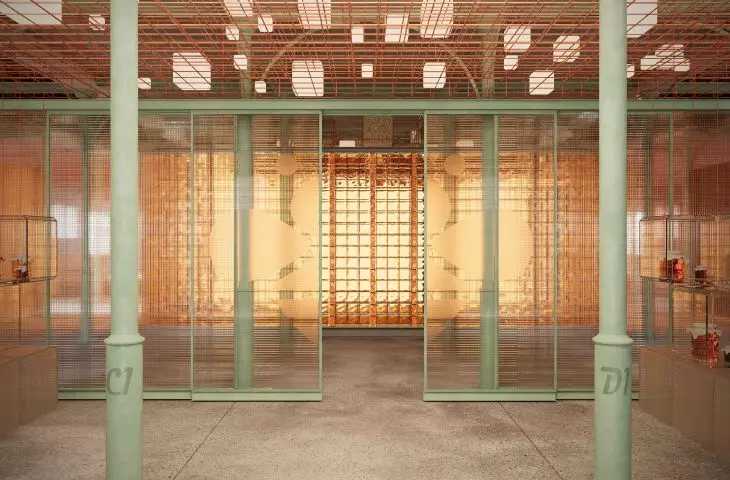Work submitted for the competition
"Best Diploma of Interiors 2022/2024".
In the thesis entitled. "How to survive? Bees the heart of the ecosystem. Interior Adaptation Project of the Old Slaughterhouse Market Building in Poznań" I wanted to create a place dedicated to education and popularization, offering comprehensive solutions for programs aimed at raising public awareness of the threats to the lives of bees and, consequently, humans, and offering certified products of bee origin.
east elevation
© Wiktoria Terek
My goal was to familiarize people with pollinators and to change the negative stereotype - the bee only stings and buzzes. An ecological problem of ever-increasing importance, which is the dramatic situation of bees in the world, was the impetus for formulating the question "how to survive?" and creating a space that not only realizes its scale, but gives a solution to the question.
entrance
© Wiktoria Terek
In my conception, I created a place intended for audiences at all stages of education, both for those who do not necessarily want to take up bee keeping, but who would like to gain basic information, as well as for continuing beekeeping enthusiasts and scientists. I wanted to create a place that would allow the residents of Poznan to get in touch with local bee keepers and have mead on offer, in order to cultivate Polish traditions, help beekeepers attract customers and counteract adulteration of honey. The Old Slaughterhouse market building is part of the complex of a former municipal butcher shop located in the very center of Poznań. By placing a project addressing the ecological aspect of the problem related to bees and the decline in their numbers inside the slaughterhouse, I wanted to make the viewer aware that at this point, if we do not make changes in our actions towards the insects, we are condemning them to a fate similar to that of animals destined for slaughter.
communication
© Wiktoria Terek
Bees have a specific system of action when building. Several characteristics can be distinguished in it, such as modularity, creation of vertical levitating structures with the least possible interference with the existing environment, creation of "architecture within architecture". This inspired me to make specific design choices in the space. The concept is to renovate the building with the restoration of concrete on the floor and plaster on the walls. The premise of creating structures with as little interference with the existing fabric as possible meant that due to the existing detailing in the form of arches on the columns, the resulting walls were not routed all the way to the ceiling. I decided to achieve the effect of detaching the created vertical divisions from the ground and structural walls by applying I-beams at the interface with the existing structures. I included the procedure of creating architecture within architecture in three central forms - honeypots, which, like in a beehive, perform the most important function in the object.
educational space
© Wiktoria Terek
They have an educational character and are an important part of the aesthetic experience. Referring to modular slice building, I used the basic architectural module - the square - and used it to create structures in the building space.
I designed the interior of the building according to the axial layout of the building. I included structural columns that give rhythm and florid specificity to the space. Due to the multi-threaded narrative, I separated 9 residence zones in the building. I was keen on clear communication and allowing the temporary change of function of the retail and catering zones for the Saturday bee market.
gastronomic space
© Wiktoria Terek
In the transformation zones of the space's use, I designed furniture forms that slide out from under the floor. They play the role of storage, display, allow consumption of the gastronomic customer and purchase of products from the self-service store. During the market, they form stands for beekeepers.
In the educational zone, they allow different types of education. Forms appear for the duration of a specific event, adapting the space for honey and mead tasting classes, beekeeping workshops and lectures on environmental issues. The main entrance to the building was important to me. I wanted it, like the entrance to the hive, to be a mysterious harbinger of the interior. I separated it with a glass vestibule, filled it with the sound of a bee swarm, and placed displays with the store's assortment of products and honeycombs with small bee products.
retail space
© Wiktoria Terek
Honey, its structure, the cultural associations associated with bees and their disappearance from the ecosystem were the inspiration for the color scheme in the interior. In order to minimize the carbon footprint, I used local products - reduced CO2 concrete, acacia wood, clay plaster, copper, ceramic products - to finish the project. I covered the exterior walls in the interior with a manifesto against bees in three languages in sgraffito technique. Honey-colored glass blocks form the structure of the honeypot. I soundproofed the interior with acoustic panels containing dried field flowers in their structure, and hung honey vines under the skylights.
sanitation
© Wiktoria Terek
{tag:studenci}
Illustrations: © Author










































